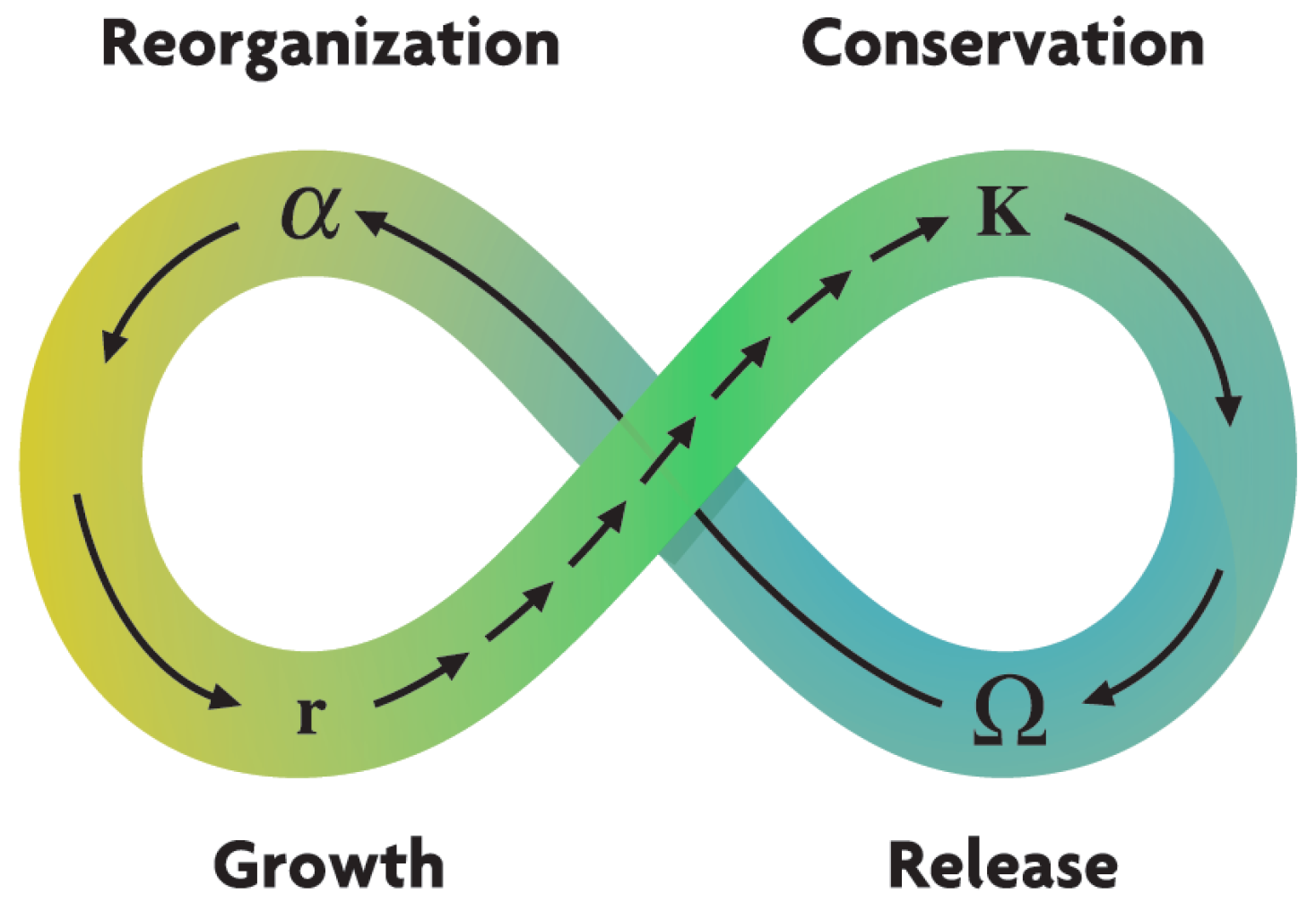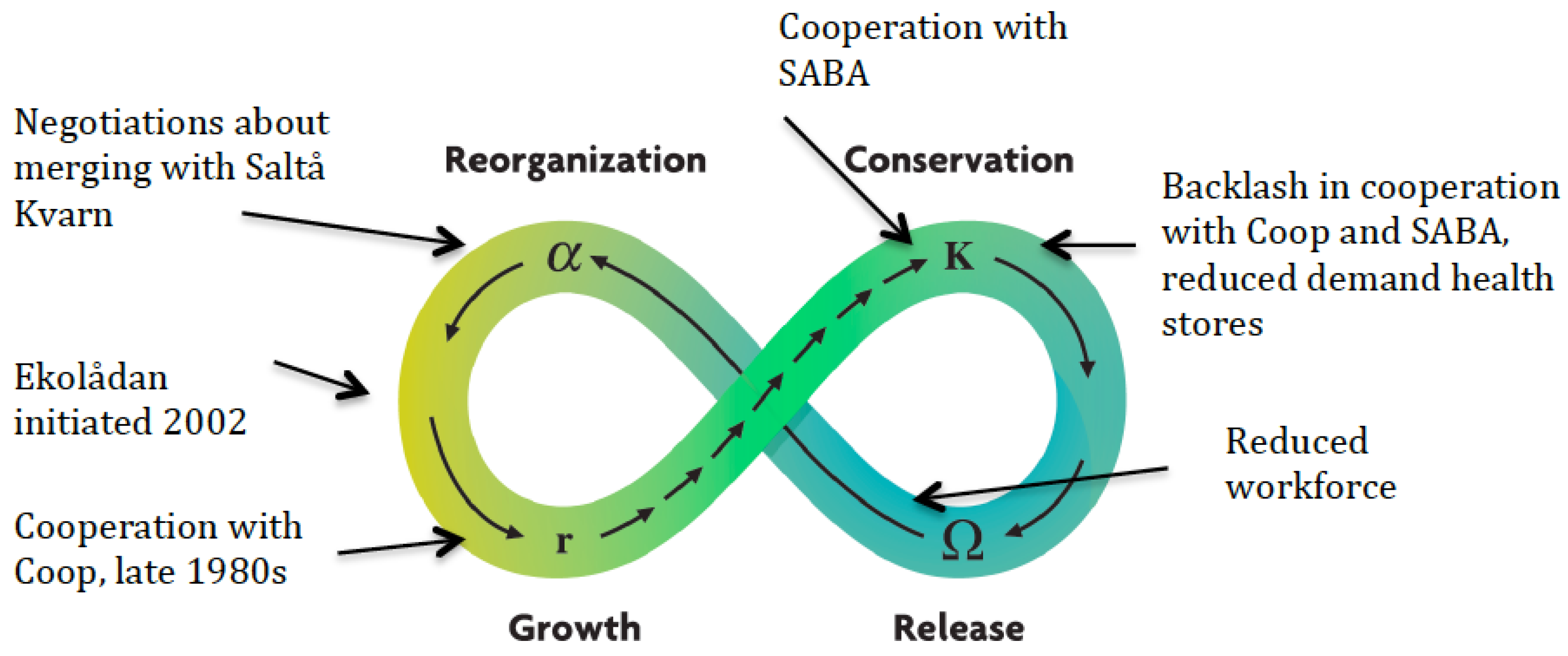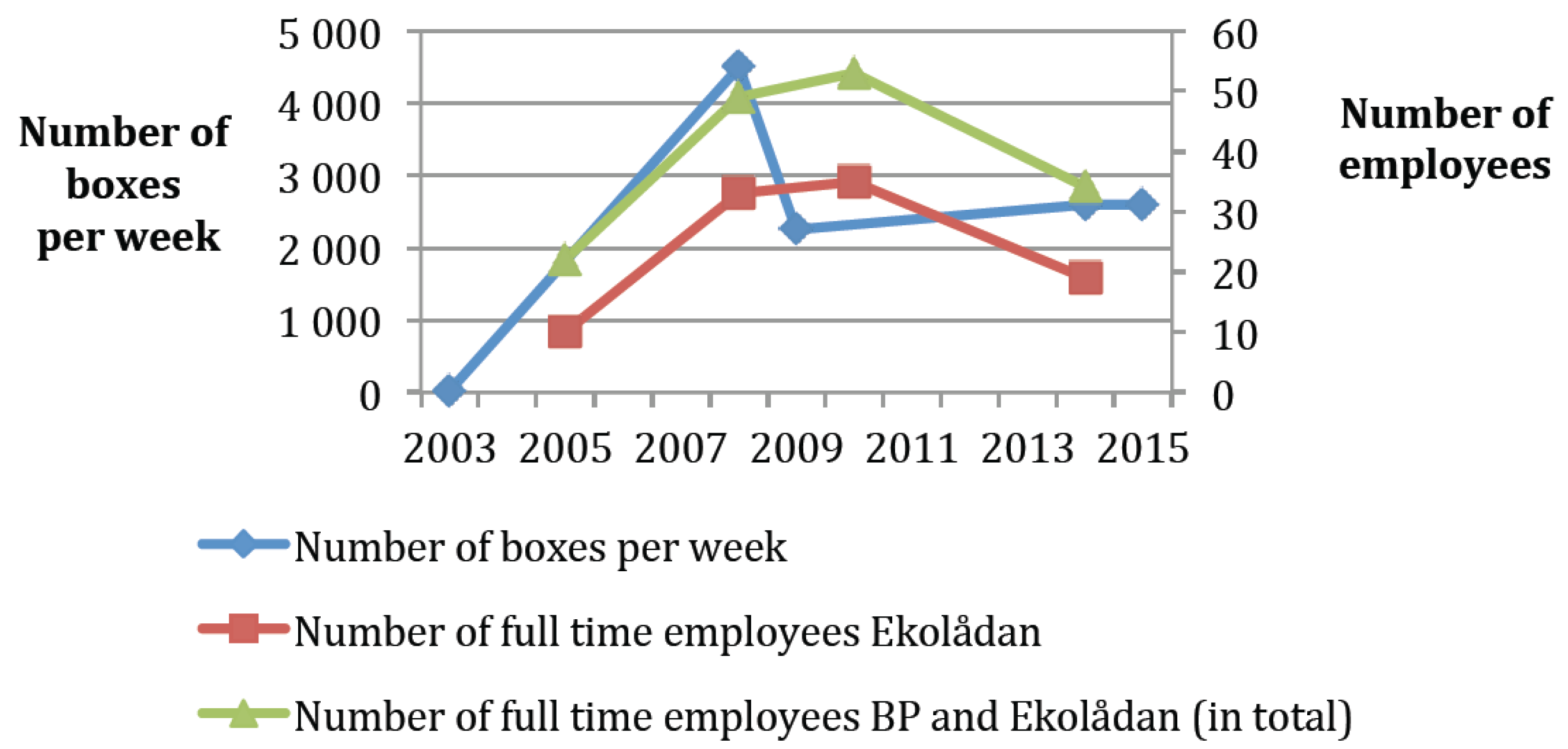The Resilience of a Sustainability Entrepreneur in the Swedish Food System
Abstract
:1. Introduction
2. Entrepreneurship and Resilience
2.1. Entrepreneurs and Entrepreneurship
2.2. Resilience and the Adaptive Cycle
3. Case-Study Approach: Materials and Methods
3.1. The Case Study
3.2. Methods
4. Social and Sustainability Entrepreneurship in BP and Ekolådan
4.1. BP as a Social Entrepreneurship Organization
4.2. Sustainability Entrepreneurship
5. The Resilience of BP and Ekolådan
5.1. Biodynamic Products, 1966–Early 1980s (Cycle I)
5.2. Biodynamic Products, Late 1980s–2002 (Cycle II)
5.3. Ekolådan, 2003–2015 (Cycle III)
5.4. On a Conservative Business Profile
6. Discussion and Conclusions
6.1. Social and Sustainability Entrepreneurship
6.2. The Resilience of BP
6.3. Conclusions
Acknowledgments
Author Contributions
Conflicts of Interest
References
- Walker, B.H.; Holling, C.S.; Carpenter, S.; Kinzig, A. Resilience, adaptability, and transformability in social-ecological systems. Ecol. Soc. 2004, 9, article 5. Available online: http://www.ecologyandsociety.org/vol9/iss2/art5/ (accessed on 20 May 2016). [Google Scholar]
- Holling, C.S. Resilience and Stability of Ecological Systems. Annu. Rev. Ecol. Syst. 1973, 4, 1–23. [Google Scholar] [CrossRef]
- Adger, N.; Hughes, T.; Folke, C.; Rockström, J. Social-Ecological Resilience to Costal Disasters. Science 2005, 309, 1036–1039. [Google Scholar] [CrossRef] [PubMed]
- Hamel, G.; Välikangas, L. The Quest for Resilience. Harv. Bus. Rev. 2003, September, 52–63. [Google Scholar]
- Doeksen, A.; Symes, D. Business Strategies for Resilience: The Case of Zeeland’s Oyster Industry. Sociol. Ruralis 2015, 55, 325–342. [Google Scholar] [CrossRef]
- Milestad, R. Building Farm Resilience. Prospects and Challenges for Organic Farming. Ph.D. Thesis, The Swedish University of Agricultural Science, Uppsala, Sweden, 4 April 2003. [Google Scholar]
- Sinclair, K.; Curtis, A.; Mendham, E.; Mitchell, M. Can resilience thinking provide useful insights for those examining efforts to transform contemporary agriculture? Agric. Hum. Values 2014, 31, 371–384. [Google Scholar] [CrossRef]
- Folke, C. Resilience: The emergence of a perspective for social-ecological systems analyses. Glob. Environ. Chang. 2006, 16, 253–267. [Google Scholar] [CrossRef]
- SEED. Turning Ideas into Impact: Setting the Stage for the Next 10 Years of Green and Inclusive Growth through Entrepreneurship; SEED: Berlin, Germany, 2015. [Google Scholar]
- Hall, J.K.; Danke, G.A.; Lenox, M.J. Sustainable development and entrepreneurship: Past contributions and future directions. J. Bus. Ventur. 2010, 25, 439–448. [Google Scholar] [CrossRef]
- Avery, G.C.; Bergsteiner, H. Sustainable leadership practices for enhancing business resilience and performance. Strateg. Leadersh. 2011, 39, 5–15. [Google Scholar] [CrossRef]
- Larsson, M.; Andersson, A.; Enberg, S. Trust and Resilience—A Case Study of Environmental Entrepreneurs in Järna. Available online: http://www.vaxteko.nu/html/sll/slu/ekologiskt_lantbruk/EKL47/EKL47AMETA.HTM (accessed on 8 June 2016).
- Gibb, A. Effective Policies for Small Business. A Guide for the Policy Review Process and Strategic Plans for Micro, Small and Medium Enterprise Development; OECD/United Nations Industrial Development Organization (UNIDO): Paris, France, 2004. [Google Scholar]
- Lundström, A.; Stevenson, L. Entrepreneurship Policy: Theory and Practice; Springer: Boston, MA, USA, 2005. [Google Scholar]
- Parrish, B.D. Sustainability-driven entrepreneurship: Principles of organization design. J. Bus. Ventur. 2010, 25, 510–523. [Google Scholar] [CrossRef]
- Johnstone, H.; Lionais, D. Depleted communities and community business entrepreneurship: Revaluing space through place. Entrep. Region Dev. 2004, 16, 217–233. [Google Scholar] [CrossRef]
- Abu-Saifan, S. Social Entrepreneurship: Definition and Boundaries. Tech. Innov. Manag. Rev. 2012, 2, 22–27. Available online: http://timreview.ca/article/523 (accessed on 9 June 2016). [Google Scholar]
- Thake, S.; Zadek, S. Practical People, Noble Cause: How to Support Community-Based Social Entrepreneurs; New Economics Foundation: London, UK, 1997. [Google Scholar]
- Bacq, S.; Janssen, F. The multiple faces of social entrepreneurship: A review of definitional issues based on geographical and thematic criteria. Entrep. Region. Dev. 2011, 23, 373–403. [Google Scholar] [CrossRef]
- Schaper, M. The essence of ecopreneurship. Greener Manag. Int. 2002, 2002, 26–30. [Google Scholar] [CrossRef]
- Shaper, M. Making Ecopreneurs: Developing Sustainable Entrepreneurship; Gower Publishing: Farnham, UK, 2010. [Google Scholar]
- Walley, L.; Taylor, D.; Greig, K. Beyond the visionary champion: Testing a typology of green entrepreneurs. In Making Ecopreneurs: Developing Sustainable Entrepreneurship; Schaper, M., Ed.; Gower Publishing: Farnham, UK, 2010. [Google Scholar]
- Steyaert, C.; Katz, J. Reclaiming the space of entrepreneurship in society: Geographical, discursive and social dimensions. Entrep. Region Dev. 2004, 16, 179–196. [Google Scholar] [CrossRef]
- Parrish, B.D.; Tilley, F. Sustainability entrepreneurship: Charting a field in emergence. In Making Ecopreneurs: Developing Sustainable Entrepreneurship; Shaper, M., Ed.; Gower Publishing: Farnham, UK, 2010. [Google Scholar]
- Schaltegger, S.; Wagner, M. Sustainable entrepreneurship and sustainability innovation: Categories and interactions. Bus. Strategy Environ. 2011, 20, 222–237. [Google Scholar] [CrossRef]
- Pretty, J.; Ward, H. Social Capital and the Environment. World Dev. 2001, 29, 209–227. [Google Scholar] [CrossRef]
- Fukuyama, F. Social capital, civil society and development. Third World Q. 2001, 22, 7–20. [Google Scholar] [CrossRef]
- Pretty, J. Social Capital and the Collective Management of Resources. Science 2003, 302, 1912–1914. [Google Scholar] [CrossRef] [PubMed]
- Olsson, P.; Folke, C.; Hahn, T. Social-ecological transformation for ecosystem management: The development of adaptive co-management of a wetland landscape in southern Sweden. Ecol. Soc. 2004, 9, article 2. Available online: http://www.ecologyandsociety.org/vol9/iss4/art2/ (accessed on 20 May 2016). [Google Scholar]
- Dietz, T.; Ostrom, E.; Stern, P.C. The Struggle to Govern the Commons. Science 2003, 302, 1907–1912. [Google Scholar] [CrossRef] [PubMed]
- Aldrich, D.P.; Meyer, M.A. Social Capital and Community Resilience. Am. Behav. Sci. 2015, 59, 254–269. [Google Scholar] [CrossRef]
- Bernier, Q.; Meinzen-Dick, R. Networks for Resilience-The Role of Social Capital; International Food Policy Research Institute: Washington, DC, USA, 2014. [Google Scholar]
- Hahn, T.; Nykvist, B. Are adaptations self-organized, autonomous and harmonious? Assessing the social-ecological resilience literature. Ecol. Soc. 2016. submitted. [Google Scholar]
- Swedish Environmental Protection Agency. Sweden’s Environmental Objectives. Available online: http://www.miljomal.se/sv/Environmental-Objectives-Portal/ (accessed on 10 June 2016).
- Linnenluecke, M.K.; Griffiths, A.; Winn, M. Extreme weather events and the critical importance of anticipatory adaptation and organizational resilience in responding to impacts. Bus. Strategy Environ. 2012, 21, 17–32. [Google Scholar] [CrossRef]
- Lengnick-Hall, C.A.; Beck, T.E.; Lengnick-Hall, M.L. Developing a capacity for organizational resilience through strategic human resource management. Hum. Resour. Manag. R. 2011, 21, 243–255. [Google Scholar] [CrossRef]
- Kantur, D.; İşeri-Say, A. Organizational resilience: A conceptual integrative framework. J. Manag. Organ. 2012, 18, 762–773. [Google Scholar] [CrossRef]
- Cameron, K.S.; Dutton, J.E.; Quinn, R.E.; Wrzesniewski, A. Developing a discipline of positive organizational scholarship. In Positive Organizational Scholarship. Foundations of a new Discipline; Cameron, K.S., Dutton, J.E., Quinn, R.E., Eds.; Berrett-Koehler Publishers: San Francisco, CA, USA, 2003; pp. 361–370. [Google Scholar]
- Holling, C.S. Resilience of ecosystems; local surprise and global change. In Sustainable Development of the Biosphere; Clark, W.C., Munn, R.E., Eds.; Cambridge University Press: Cambridge, UK, 1986; pp. 292–317. [Google Scholar]
- Holling, C.S. Understanding the Complexity of Economic, Ecological, and Social Systems. Ecosystems 2001, 4, 390–405. [Google Scholar] [CrossRef]
- Schumpeter, J. Capitalism, Socialism and Democracy; Harper and Row: New York, NY, USA, 1950. [Google Scholar]
- Folke, C.; Carpenter, S.; Walker, B.; Scheffer, M.; Chapin, T.; Rockström, J. Resilience Thinking: Integrating Resilience, Adaptability and Transformability. Ecol. Soc. 2010, 15, article 20. Available online: http://www.ecologyandsociety.org/vol15/iss4/art20/ (accessed on 9 June 2016). [Google Scholar]
- Ekolådan. Ekolådans rötter (The Roots of Ekolådan). Available online: www.ekoladan.se (accessed on 7 July 2014).
- KRAV. Available online: www.krav.se (accessed on 10 June 2016).
- Svenska Demeterförbundet (The Swedish Demeter Association). Available online: www.demeter.nu (accessed on 10 June 2016).
- Milestad, R.; von Oelreich, J. Full Case Study Report: Ekolådan-Sweden; KTH Royal Institute of Technology: Stockholm, Sweden, 2015. [Google Scholar]
- Biernacki, P.; Waldorf, D. Snowball sampling: problems and techniques of chain referral sampling. Sociol. Method Res. 1981, 10, 141–163. [Google Scholar]
- Kvale, S.; Brinkmann, S. Interviews: Learning the Craft of Qualitiative Research Interviewing; SAGE Publications Ltd.: London, UK, 2009. [Google Scholar]
- BP’s Charter. Available online: http://web05.lansstyrelsen.se/stift/StiftWeb/FoundationDetails.aspx?id=1000180 (accessed on 10 June 2016).
- Johansson, B. Är eko reko? Om ekologisk lantbruk i Sverige (Is Organic Fair? Organic Agriculture in Sweden); The Swedish Research Council Formas: Stockholm, Sweden, 2003. [Google Scholar]
- Johannisson, B. Entrepreneurship—The making of new realities. In De Glesa Strukturerna i den Globala Ekonomin (The Thin Structures of the Global Economy); The Royal Academy of Agriculture and Forestry: Stockholm, Sweden, 2002. [Google Scholar]
- O’Brien, K. Global environmental change II: From adaptation to deliberate transformation. Prog. Hum. Geogr. 2012, 36, 667–676. [Google Scholar] [CrossRef]
- Axelsson, B. A Conventions Theory Analysis of Farmers in the Ekolådan Distribution Network—Justifications and Conventions. Master’s Thesis, Stockholm University, Stockholm, Sweden, 31 May 2012. [Google Scholar]
- Ekoweb. Ekologisk livsmedelsmarknad 2015 (Organic Food Market 2015). Available online: http://www.ekoweb.nu/?p=11363 (accessed on 8 January 2016).
- KRAV. Market Report 2014. Available online: http://www.krav.se/forsaljning-2013 (accessed on 8 January 2016).
- KRAV. Market Report 2015. Available online: http://www.krav.se/marknadsrapport-2015/forsaljning (accessed on 8 January 2016).
- Ekoweb. Ekologisk Livsmedelsmarknad 2016 (Organic Food Market 2016). Available online: http://www.e-pages.dk/maskinbladet/1180/ (accessed on 24 April 2016).






| Respondent | Position at Ekolådan/BP | Number of interviews * |
|---|---|---|
| R1 | Chair of BP’s board | 3 |
| R2 | Newsletter writer, former quality manager | 1 |
| R3 | Senior purchaser | 1 |
| R4 | Farmer delivering to BP and Ekolådan | 2 |
| R5 | Responsible for customer service | 1 |
| R6 | Founder and former CEO of BP | 1 |
| Criteria Defining a Social Entrepreneurship Venture * | Biodynamic Products |
|---|---|
| 1. Its social mission must be explicit and central. | “Any profits from the foundation’s operations…will be handed over as a gift… ” ** |
| 2. Its market orientation must be consistent with its social mission. | “Operations shall be run in continuous co-operation with the consumers and producers of the company’s products, and its operations shall mirror the consumers’ demand for biodynamic foods and the producers’ ability to grow and sell these”. ** |
| 3. The legal framework does not define SEVs; they can be found in the private for-profit sector and in the public sector. | Both structures, private company and foundation, have been shown to suit BP’s purposes. |
| Sustainability Entrepreneurship Attribute | Reference | Findings in BP |
|---|---|---|
| Ethical business case related to social and environmental sustainability. | Bacq and Janssen [19]; Schaltegger and Wagner [25]. | BP is clearly value-driven, based on its charter. |
| High level of trust within staff and towards clients. | Avery and Bergsteiner [11]; Schaltegger and Wagner [25]. | Trust-building is a key characteristics of the whole business model. |
| Promoting a cause beyond the success of the business. | SEEDS [9]; Parrish and Tilley [24]. | BP did not scale up itself, but helped forming a niche, which inspired other entrepreneurs to expand the organic market. |
| Long-termism. | Gibb [13]; Schaltegger and Wagner [25]. | The charter of BP emphasizes long-term strategies over short-term success. |
| High adaptive capacity, including renewal after crises (resilience) and innovation. | Schaltegger and Wagner [25]. | Both BP and Ekolådan have survived crises by innovation. |
| Organizational Resilience | Reference | Findings in BP |
|---|---|---|
| Ability to renew itself and self-organize after crisis | Hamel and Välikangas [4]; Folke [8] | BP has shown capacity for self-organization and renewal after crises in the mid-1970s and late 1990s. |
| Adaptation is sometimes not enough, and transformation is required | Sinclair et al. [7] | BP has, over time, both adapted (in terms of products) and transformed (in organizational form) depending on conditions. |
| The importance of control and independence | Milestad [6] | BP has privileged independence and control over growth. |
| Learning and innovation, especially in the α phase | Linnenluecke et al. [35]; Lengnick-Hall et al. [36] | BP has innovated continuously, introducing organic coffee, fruits and meat in Sweden, as well as the box scheme Ekolådan. |
| Organizational culture and working environment that stimulates flexibility and innovation | Lengnick-Hall et al. [36] | BP fosters trust, informality and flexibility with employees, promoting experimentation. |
| Value-based contextual integrity and wisdom generates authenticity, trust and loyalty | Kantur and İşeri-Say [37]; Cameron et al. [38]; Aldrich and Meyer [31]; Bernier and Meinzen-Dick [32] | BP enjoys a strong local trademark and integrity as idealistic biodynamic enthusiasts. This provides authenticity, trust and loyalty among customers: “They know what we stand for”. |
© 2016 by the authors; licensee MDPI, Basel, Switzerland. This article is an open access article distributed under the terms and conditions of the Creative Commons Attribution (CC-BY) license (http://creativecommons.org/licenses/by/4.0/).
Share and Cite
Larsson, M.; Milestad, R.; Hahn, T.; Von Oelreich, J. The Resilience of a Sustainability Entrepreneur in the Swedish Food System. Sustainability 2016, 8, 550. https://doi.org/10.3390/su8060550
Larsson M, Milestad R, Hahn T, Von Oelreich J. The Resilience of a Sustainability Entrepreneur in the Swedish Food System. Sustainability. 2016; 8(6):550. https://doi.org/10.3390/su8060550
Chicago/Turabian StyleLarsson, Markus, Rebecka Milestad, Thomas Hahn, and Jacob Von Oelreich. 2016. "The Resilience of a Sustainability Entrepreneur in the Swedish Food System" Sustainability 8, no. 6: 550. https://doi.org/10.3390/su8060550
APA StyleLarsson, M., Milestad, R., Hahn, T., & Von Oelreich, J. (2016). The Resilience of a Sustainability Entrepreneur in the Swedish Food System. Sustainability, 8(6), 550. https://doi.org/10.3390/su8060550





